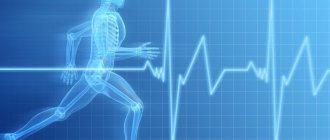Anxiety-depressive disorder is a large group of diseases that refers to a wide variety of conditions. This is a certain set of factors, and the first of these factors are certain prerequisites for the appearance of an anxiety-depressive disorder in a person. Such prerequisites do not directly depend on the person, but are rooted in childhood, for example, if one of the parents was suspicious or emotional, then this was one of the first prerequisites for this type of disorder. Or in early childhood the person experienced severe stress (violence, illness).
Causes
The term “hypotension” literally means “low blood pressure,” but orthostatic hypotension is a sharp decrease in blood pressure after a change in body position in space. Changing position causes blood to flow from the head to the feet. In response to this process, the heart rate accelerates and blood vessels constrict, leading to a rapid increase in blood pressure.
Redistribution of blood when body position changes
Within a short time, the body can return blood to the head. However, if this reaction occurs too slowly, cerebral hypoperfusion occurs.
It is not orthostatic hypotension that is life-threatening, but the resulting injury caused by loss of consciousness.
Often, with age, the ability to normal orthostatic reaction is partially lost. But some diseases are also considered a risk factor for the development of orthostatic syndrome . These include primarily diabetes mellitus and diseases of the nervous system .
Subscribe to our INSTAGRAM account!
Another possible cause of orthostatic dysregulation is the use of certain medications. Most often, orthostatic hypotension is caused by vasodilators - drugs that dilate blood vessels.
Blood pressure can also be reduced by diuretics, cytostatics, antiparkinsonian drugs and angiotensin converting enzyme inhibitors. Some tranquilizers, tricyclic antidepressants, opiates, psychostimulants, insulin, muscle relaxants, alcohol and cannabinoids such as marijuana are triggers for the disease.
Rarer causes include heart failure, congenital heart defects, hypothyroidism, and mental disorders (phobias, trauma, or depression).
How to treat phobic neurosis in humans
Treatment for a problem such as phobic neurosis can begin only after the sick person visits a specialist. Under no circumstances should you treat neurosis at home or rely on your own strength and knowledge. In addition, treatment should under no circumstances be carried out using various types of medications. This can not only cause numerous complications, but also provoke a more intense development of phobic neurosis.
If the sick person’s condition has not yet advanced, and the problem is just beginning to develop (this can most often be found in childhood), then this type of neurosis can only be cured with the help of a good specialist in the field of psychology. He will be able to literally determine the cause of the problem in just a few treatment sessions; several more visits will be needed to eliminate the phobic neurosis.
As a rule, several methods are used to treat phobic neurosis.
They can be used individually or all together, even simultaneously.
Cognitive behavioral therapy is used quite often. This treatment method is considered the most effective and is one of the standard methods in psychotherapy. Without using this method, it is unlikely that it will be possible to cure neurosis. With the help of such therapy, you can easily and quickly remember, as well as determine what exactly causes fear. Cognitive behavioral therapy helps the patient understand himself and finds a way that helps eliminate this fear. Psychotherapy allows you to teach a sick person to properly and fully control their emotions, remove anxiety and overcome panic.
Various types of antidepressants, beta blockers, antipsychotics and special drugs that can quickly calm the nervous system of a sick person are used as treatment with medications. At the same time, it is worth remembering that phobic neurosis cannot be overcome with the help of drug treatment alone. The use of medications must be combined with visits to a psychotherapist.
Symptoms
Orthostatic dysregulation is characterized by nonspecific symptoms. As a rule, they appear after a sudden change in body position . If a person lies down for a longer period of time, symptoms may be even worse.
Common symptoms of orthostatic hypotension:
- Feeling cold.
- Nausea.
- Pallor.
- Excessive sweating.
- Inner restlessness.
In addition, tachycardia, a feeling of fear, dizziness, headache, a feeling of unsteadiness while walking, tinnitus, spots before the eyes and a feeling of emptiness in the head are often observed.
Due to symptoms, the patient is forced to sit or lie down. In this case, symptoms usually disappear quickly. In some situations, brief fainting is also possible, which can lead to injury.
Psychotherapy of anxiety-phobic disordersPavel Alekseevich Fedorenko
PREFACE
Let's imagine an ordinary, average person living an ordinary, average life. In the morning he goes to study or work, in the evening he goes to sports training or relaxation with his family, on weekends and holidays he goes to meet friends, accompanied by alcohol consumption. He does not experience any health problems, leads a completely normal lifestyle, in a word, lives like everyone else. However, from time to time this sociable and cheerful person becomes dizzy, his gait becomes unsteady, his heartbeat quickens when he falls asleep, and when he gets up suddenly his eyes darken. At first, our hero does not pay any attention to these states and continues to live in his usual life.
However, the symptoms do not subside, some of them intensify and, what is especially unpleasant, new ones appear: sudden continuous trembling, tingling and numbness of the limbs, sensations of suffocation and lack of air, fever and sweating, sharp pain in the spine. This leads a person into alarming confusion: “Something is wrong with me! What if I'm really sick? Anxious thoughts are increasingly visiting our hero, but he still does not attach much importance to his symptoms, trying in every possible way to distract himself from them. But one day, while standing in a long line at a supermarket or nervously languishing in a traffic jam, a person is suddenly overcome by indescribable horror, pierced by wild anxiety, and it seems to him that he is about to faint, die, go crazy, or commit an uncontrollable action. The sensations are so sudden and strong that a person completely forgets about all social norms, begins to rush from side to side in a panic, ask for help, call an ambulance, call parents, relatives or friends.
Regardless of the outcome of events, the person ends up at home completely safe and sound. After some time, he comes to his senses and again begins to live a full life, only occasionally remembering the annoying misunderstanding, but now avoiding supermarkets and trying to avoid traffic jams just in case. But his former serene life continues until, in a new queue or traffic jam, he is again seized by an all-consuming attack of panic. From this moment on, our hero is already seriously concerned about his health and would never want to be alone in a supermarket or on a bus crowded with people. The obsessive thought that he is sick with a terrible and incurable disease has firmly taken root in his mind and is now his constant companion, wherever he finds himself.
In order to find the cause of his extremely unpleasant and difficult to bear conditions, a person naturally turns to a doctor. Heroically overcoming the stuffiness of the clinic corridors, red tape with referrals and unnecessary tests, constantly swearing at the reception desk and languishing in anticipation in a crowd of grandmothers yearning for Soviet times, he finally gets to see a doctor. However, our hero’s colorful story about his sudden panic states does not find the proper response from the doctor, who, without being distracted from the medical papers, only indifferently remarks: “You’re overtired, guy, follow your daily routine, take magnesium.” And he gives out some piece of paper with a diagnosis. Making his way through the doctor’s illegible handwriting, the person finally reads the treasured words: “vegetative-vascular dystonia”, “neurocirculatory dystonia”, “vegetative crisis” or “panic attacks”.
Despite the fact that the doctor did not find anything wrong, and the results of the medical examination did not reveal any fatal disease or even pathology, our hero’s condition is rapidly deteriorating. New symptoms and fears arise: severe dizziness and faintness, stomach pain and intestinal upset, fear of screaming in the street and dying of a heart attack. The thought creeps into a person’s mind that he has been underexamined, and he launches a cascade of meaningless studies, spending a huge amount of money, effort and time on encephalograms and endoscopies, which again do not reveal any abnormalities. But, having done another magnetic resonance imaging scan and looking at the diagnosis, our hero is horrified by the huge number of complex medical terms, not realizing that this examination is performed by diagnosticians who only describe what they see in the human body, and that only a doctor can make a direct diagnosis.
The person begins to intimidate himself, especially as his health continues to deteriorate. Now, when going outside, the world begins to be seen as in a movie, the reflection in the mirror is perceived as someone else’s, and even strange and frightening thoughts appear to harm oneself or a loved one, jump out of a window, beat up a friend or parents. How can you not think about madness? Overcoming shame, a person turns to a psychologist, psychiatrist or psychotherapist, but all to no avail: “No one seems to have diagnosed schizophrenia, or maybe they just don’t tell me that I have a mental disorder, not wanting to scare me.” Continuing his crusade to doctors and spending his last money on various examinations, our hero, it seems to him, finds the cause of his suffering. It turns out that all this time he had mitral valve prolapse. But this is not so bad, because in addition he has a right bundle branch block.
It’s clear that our hero’s anxious thinking begins to draw chilling pictures in his creative imagination, like some valve, being in absolute prolapse, is about to stop opening or closing, or, even worse, it will come off and circulate throughout the body, guided by blood circulation. And the blockade does not bode well. Fantasy immediately sends a person to the siege of Leningrad, which lasted 871 days, which means that our hero will have to suffer no less. No less alarming is the right leg, which for some reason is only one (apparently the left one has died off long ago) and, moreover, is defective, otherwise it would be called a “leg” and not a pathetic “leg”. The bundle that came from unknown where does not add optimism, especially considering that it belongs to some Gisu, who very much resembles a sly fox.
And it’s good if, before a person’s fantasy plays out, they explain to him that every second person has such diagnoses and that they do not pose any threat to the body. However, our hero has not trusted anyone for a long time and is intimidated to such an extent that he does not leave the house again, has stopped all communication with friends and quit his job, fearing to provoke a panic attack. He understands more and more clearly that with such diagnoses there is no need to buy a long-playing record, since there is a high probability of not listening to it to the end. Having voluntarily imprisoned himself in the “prison” walls of his home, a person lives in the illusion that home is the only safe place on Earth, as if he has a resuscitation kit under his bed for emergency medical care, and a team of orderlies is on duty in the next apartment around the clock. How can one not recall the wise minnow Saltykov-Shchedrin and Chekhov’s man in a case, tirelessly worrying about how things won’t work out!
But our hero has no time for jokes. He is exhausted by endless anxiety, constantly changing symptoms and acute surges of panic. He is broken, exhausted and does not know how to live further. Thoughts rush through my head one after another: “My life has turned into a nightmare! I'll never get out of this! Why do I need this? Why is this happening to me? Why do other people live happily, and only I suffer?” Apathy and depressive mood are strengthened by the thought that his condition is divine punishment, punishment from fate, or in general the evil eye and damage. Parents or relatives add fuel to the fire, who at first feel sorry for our hero, and as time passes, realizing that he is most likely just being a fool, they begin to get angry and swear at him. But the lack of support from loved ones gives rise to the desire to show that the person is really feeling bad, which causes even more severe panic attacks.
Tired of endless examinations and accusations from relatives, our hero seemed to completely give up, but suddenly he remembered how often people come across incompetent doctors: either they make the wrong diagnosis, or they prescribe the wrong medicine, or they completely forget the scalpel inside a living person: “How come I didn’t think of this before! We must look for alternative methods of treatment!” Extremely desperate and devastated, a person grabs onto any methods of “healing” that he had either never heard of before or had not even thought about. But turning to hypnotists and psychics, going to grandmothers-healers and fortune-tellers, taking homeopathic medications and dietary supplements, acupuncture and massage, cleaning karma and dry-cleaning the brain do not bring a lasting effect, and antidepressants only make things worse. And, what’s saddest, even going to church and long conversations with the rector did not change anything.
Realizing that, apparently, he got carried away with esoteric practices, folk remedies, dubious drugs and alternative medicine, our hero remembers the cherished “Oh sport! You are the world! and begins to engage in intense physical activity and lead a healthy lifestyle. Having given up alcohol and cigarettes, he now does exercises and jogging in the morning, douses himself with cold water, goes to a massage and a swimming pool, tries to eat right, get enough sleep and follow a daily routine. However, our hero is missing for a long time, especially since one day, wanting to solve all the problems in one fell swoop, he overdid it in the gym and felt severe deterioration: his heart was beating like crazy and could not calm down, provoking another wave of panic, which, in turn, became a source of cardiophobia and obsessive actions in the form of constant measurement of heart rate. Worse, now he is beginning to suffer from extrasystoles - absolutely harmless additional heart beats, which are each time perceived as a stroke, although in fact they are a clear indicator of good health.
But our hero’s torment did not end there. To the bouquet of various symptoms, panic attacks, obsessive thoughts, depression and apathy were added irritability for any reason and poor concentration. A person grabs onto Internet resources like the last saving straw. Frantically typing his symptoms and diagnoses into the search bar, he ends up on medical sites that describe his problem in detail. However, being in an anxious state, a person does not dwell on positive information and, arbitrarily comparing different parts of the text, makes his own interpretation of the information, finding more and more new diseases that the body will not be slow to imitate. Completely intimidated by his own thoughts, our hero finally encounters various Internet forums, from which he learns that the symptoms of vegetative-vascular dystonia cannot be treated, that panic attacks are a mental illness, and that he will remain “disabled” forever.
It seems that this state of affairs puts an end to the happy life of our hero, who in his current state will never be able to meet a girl, start a family and get at least some kind of job, not to mention self-realization, travel, entertainment... Locked in his own at home, tormented by endless symptoms, panic attacks, obsessive thoughts and actions, a person eventually loses all desire to live. Friends are perplexed and gradually cut off contact with the person, parents give up and accept what is happening, not without irritation, and our hero seems to be finally slipping into depression. And if you read this book, then, most likely, you will fully or partially recognize yourself in this suffering hero.
What is happening to you? Why do you need this unbearable torment? The answer is very simple. Various symptoms of vegetative-vascular dystonia, panic attacks, obsessive thoughts and actions, fears of going crazy, committing an uncontrollable action or contracting an incurable disease are just a consequence of an increased level of anxiety resulting from prolonged overexertion and regular stress. That's all? Exactly! From now on, you need to constantly keep this banal, but extremely important thought in your head, which will significantly ease your experiences that prevented you from choosing the right path of “healing.” So, we received good news: you are not sick, although you are suffering. But there is one more thing: the magic pill that you have been looking for for so long is inside you. And the only way to get rid of debilitating anxiety is to start changing gradually, and you need to start right from this day.
Now you clearly understand that all this time, like tilting at windmills, you were fighting not the cause, but the consequence of your anxiety—the symptoms. And instead of giving your body the time it needed to recover, you tired it out day after day by constantly worrying about your symptoms, thereby increasing stress and driving yourself into a vicious cycle. You tried to get rid of tachycardia, osteochondrosis, headache, weakness and other symptoms of high anxiety, but did not eliminate the cause itself - increased anxiety. By struggling with the symptoms, you created new tension each time, which constantly increased your anxiety, which produced new symptoms. And the struggle of Hercules in your face with the multi-headed Lernaean hydra in the form of symptoms dragged on: cutting off one head (read - fighting with one symptom), you received three heads in return in the form of an intensification of the old or the emergence of new symptoms. But the paradox is that you will not improve your condition while you try to improve it. Therefore, the first thing you need to do to get rid of your problems is to stop doing anything to get rid of them. But this book is about how to do nothing correctly and what exactly you should not do.
.
Diagnostics
In medical practice, the Shellong test is used to diagnose postural hypotension. During the test, the patient lies on a couch for 5-10 minutes while their blood pressure and heart rate are measured. He should then quickly stand up and remain standing for 5-10 minutes. During this period, pulse and blood pressure are monitored.
With a sharp change in body position in patients with orthostatic hypotension, blood pressure sharply decreases.
To clarify the diagnosis, it is also necessary to exclude other possible causes of dizziness.
Treatment and therapy
Treatment of orthostatic dysregulation should be carried out without the use of medications . Only in severe cases can the patient take alpha-adrenergic agonists.
To counteract the hypotension that usually occurs in the morning, it is recommended to do exercises that improve blood circulation in the lower extremities. Thus, venous return can be stimulated by activation of the lower leg muscles even in the supine position.
Before getting out of bed, you need to sit for at least 2 minutes.
It is also recommended to reduce the room temperature, since cold also increases venous return.
In some cases, strong coffee may help reduce symptoms of postural hypotension.
In most cases, treatment for postural vertigo is not necessary. The disease does not cause serious damage to organ systems.
Complications
As mentioned above, the disease does not cause any particular complications and does not lead to a life-threatening condition. The main danger of a sharp decrease in blood pressure is possible injury from a fall.
An attack of postural hypotension causes short-term symptoms that do not affect either the quality of life or the course of other diseases. Published by econet.ru.
If you have any questions, ask them here
PS And remember, just by changing your consumption, we are changing the world together! © econet
Multifaceted anxiety disorder: neuroses with panic attacks
We have all experienced anxiety more than once—excitement before an important meeting for us, a final exam, or an important presentation. But what is this feeling really? Anxiety is our body's way of preparing us to take on a challenge. Our heart pumps more blood, saturating the body with oxygen - and it is ready to act. We become alert and more effective at solving physical and emotional problems. It's natural to feel anxious when our safety, health, or happiness is threatened. However, sometimes anxiety can become overwhelming and destructive and come out of nowhere. Excessive, prolonged anxiety attacks may reflect a person's developing anxiety disorder with accompanying panic attacks.










